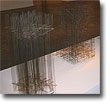Centro Cultural Recoleta ,
Dec 16, 2004 - Feb 27, 2005
Buenos Aires, Argentina
León Ferrari: Retrospective. Works 1954-2004
by Viviana Usubiaga
Also deriving from these sculptural forms are hand drawn works in which lines are converted into illegible words and manuscripts. Ferrari began to explore the behavior of his flat sculptured structures after receiving an invitation in 1962 by the collector Arturo Schwartz. The artist corrupted the codes of written language, challenging the legibility of words transformed into threads of ink on every page. Giunta affirms that the deformed writings are the result of texts altered to the extreme of unintelligibility. There coexist in them two senses: the perpetual, affecting only the forms, and the intellectual, referring to the original text, involved in the lines, which cannot be deciphered. The words, however, exist, and at times have a political meaning, as in those drawings with titles like, 'Letter to a general' (1963)(3).
The impossibility in the writing and the incomprehensibility in the reading allow for other possible interpretations withing the gaps of the sign. With words from a poem by Arturo Carrera, these plastic deformations seem to to encapsulate the following passage: el delicioso momento de / atisbar lo entintado; / y lo que caligraficamente apunta / a desnaturalizar lo escrito (The delicious moment of/ observing the words in ink;/ and what it annotates calligraphically/ to deform what is written) (4). The abstraction of the written word results in gaps. In his Manuscritos, legible texts which began in 1964, he experiments with vocabulary through plastic means. With a poetic gesture, he compiles lists of words that nobody uses. He includes in the manuscripts the first references to biblical texts. El arbol embarazador is a rewriting of the Flood. As a retrospective hypothesis, he puts forward a version in which all the men die during the flood. The women save themselves by inflating breasts and buttocks to float in the water, at the same time as Satan rescues penises, inserting them into a huge tree which the women then climb in collective copulation.
The questioning of Western cultural values are continued in his well known work: La Civilización Occidental y Cristiana. This is an assemblage prepared in 1965, referring ineludibly to the Vietnam war. He placed the image of a Santeros' Christ on a small scale replica of an FH107 war plane. In this case conceptions of writing and body are crossed. The presence of two bodies, that of martyred man representative of religion and that of machine as a discursive symbol of the war. Luis Camnitzer maintains that the aircraft becomes a cross and Christ is a complex mixture of impotent figure, suicidal terrorist and affirmative stamp supporting the genocidal activity (5) As a pacifist statement suspended in air, this crucifixion formed part of Ferrari's shipment to the National Award of the Instituto Di Tella, a cultural center that formed the nucleus of the artistic vanguard at that time, but the work was excluded from the exhibition. This was the first of a long list of acts of censorship affecting his work. La Civilización Occidental y Cristiana is a key work within the debates on art and politics in the sixties.
The techniques of collage and assemblage recur often in Ferrari’s work, either in images or words, as is the case with Palabras ajenas. This is a book constructed from a collage of textual quotes by Hitler, Goebbels, Pope Paul VI, L.B. Johnson and the Bible, among others. This imaginary dialogue between extemporary characters was a theatrical project at the London Arts Institute in 1968, with staging by Leopoldo Maler.He later returned to this device in a compilation of news clippings from Buenos Aires newspapers during the seventies. He collected hundreds of notes reporting on the appearance of the mutilated, incinerated and bullet-ridden bodies found daily in the city and on the banks of the River Plate during the dictatorship. Under the title Nosotros no sabíamos (We Didn’t Know), the phrase repeated by a large section of the population which refused to acknowledge State terrorism, he managed to pull the evidence even tighter; the written word as evidence of the body buried in the nets of newspaper records.
In the same way as he works with the words spoken by others, Ferrari writes his own. He constructs profane writings which mingle with the sacred, uncovering the infamous genealogy of religious oration and denaturalizing the sworn word. In the name of the association CIHABAPAI (Club de impos herejes apostatas blasfemos ateos paganos agnosticos e infieles)(Club of Imps, Heretics, Apostates, Blasphemers, Atheists, Pagans, Agnostics and the Unfaithful) of which he is a founding member, and accompanied by hundreds of artists' and writers' signatures, he has sent two letters addressed to Pope John Paul II asking for the Day of Judgment to be annulled (1997) and for Hell to be evacuated and dismantled in line with the repudiation of torture proclaimed by the Catholic Church (2001).
|













